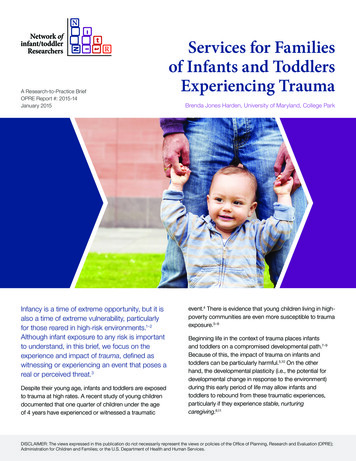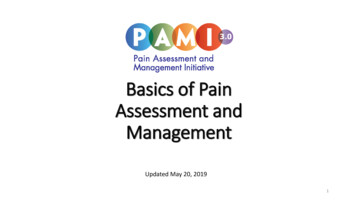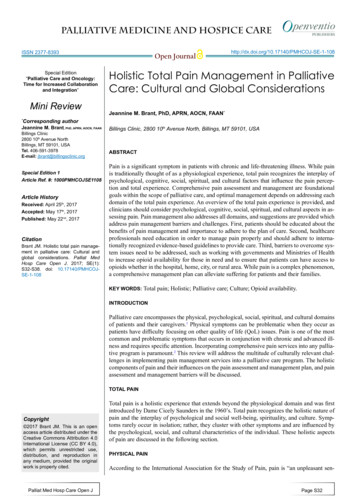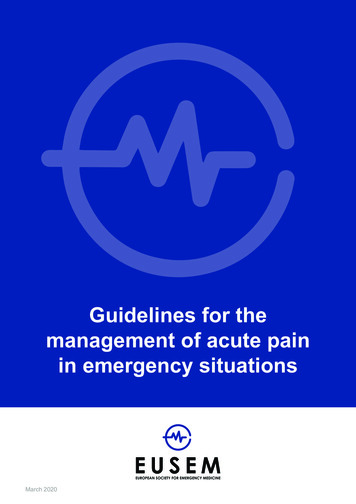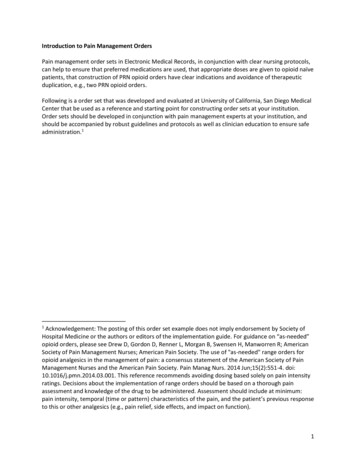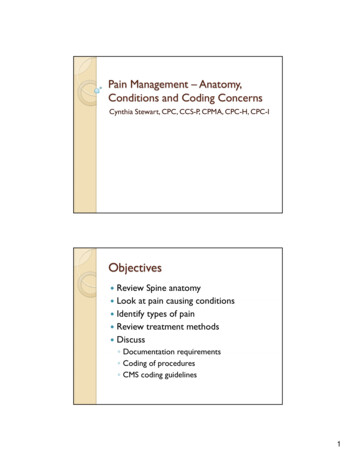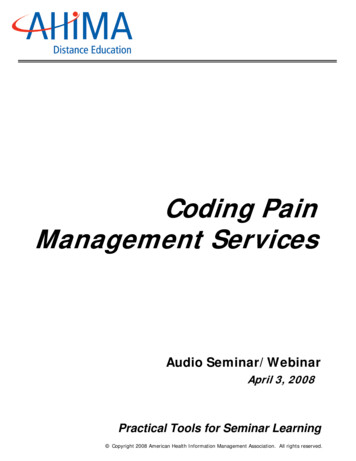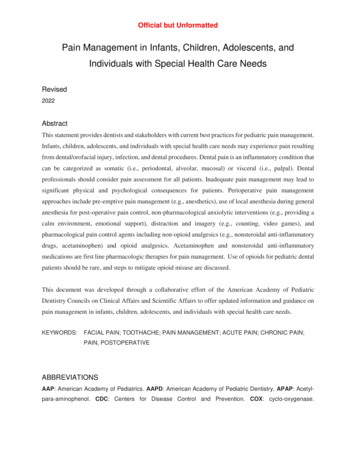
Transcription
Official but UnformattedPain Management in Infants, Children, Adolescents, andIndividuals with Special Health Care NeedsRevised2022AbstractThis statement provides dentists and stakeholders with current best practices for pediatric pain management.Infants, children, adolescents, and individuals with special health care needs may experience pain resultingfrom dental/orofacial injury, infection, and dental procedures. Dental pain is an inflammatory condition thatcan be categorized as somatic (i.e., periodontal, alveolar, mucosal) or visceral (i.e., pulpal). Dentalprofessionals should consider pain assessment for all patients. Inadequate pain management may lead tosignificant physical and psychological consequences for patients. Perioperative pain managementapproaches include pre-emptive pain management (e.g., anesthetics), use of local anesthesia during generalanesthesia for post-operative pain control, non-pharmacological anxiolytic interventions (e.g., providing acalm environment, emotional support), distraction and imagery (e.g., counting, video games), andpharmacological pain control agents including non-opioid analgesics (e.g., nonsteroidal anti-inflammatorydrugs, acetaminophen) and opioid analgesics. Acetaminophen and nonsteroidal anti-inflammatorymedications are first line pharmacologic therapies for pain management. Use of opioids for pediatric dentalpatients should be rare, and steps to mitigate opioid misuse are discussed.This document was developed through a collaborative effort of the American Academy of PediatricDentistry Councils on Clinical Affairs and Scientific Affairs to offer updated information and guidance onpain management in infants, children, adolescents, and individuals with special health care needs.KEYWORDS:FACIAL PAIN; TOOTHACHE; PAIN MANAGEMENT; ACUTE PAIN; CHRONIC PAIN;PAIN, POSTOPERATIVEABBREVIATIONSAAP: American Academy of Pediatrics. AAPD: American Academy of Pediatric Dentistry. APAP: Acetylpara-aminophenol. CDC: Centers for Disease Control and Prevention. COX: cyclo-oxygenase.
Official but UnformattedCNS: Central nervous system. FDA: U.S. Food and Drug Administration. IV: Intravenous. NSAIDs:Nonsteroidal anti-inflammatory drugs. WHO: World Health Organization.PurposeThe American Academy of Pediatric Dentistry (AAPD) recognizes that infants, children,adolescents, and individuals with special health care needs can and do experience pain due todental/orofacial injury, infection, and dental procedures, and that inadequate pain managementmay have significant physical and psychological consequences for the patient. Appreciation ofpediatric pain can help practitioners develop clinical approaches to prevent or substantially relievedental pain. When pharmacological intervention is necessary to manage pain, the practitionermust understand the consequences, morbidities, and toxicities associated with the use of specifictherapeutic agents. These recommendations are intended to provide dental professionals andother stakeholders with current best practices for pain management in pediatric dentistry.MethodsThis document was developed by the Council on Clinical Affairs and adopted in 2018.1 It is basedon a review of current dental and medical literature pertaining to pain management in pediatricdental patients. Review of existing federal and professional pain management guidelines andconsensus statements were used to assist with this document. An electronic search was conductedin the PubMed /MEDLINE database using the terms: dental pain management, pediatric painassessment, pre-emptive analgesia, paracetamol, pediatric and acetaminophen, adolescent andacetaminophen, pediatric and nonsteroidal anti-inflammatory drugs (NSAIDs), adolescent andNSAIDs, pediatric and opioids, adolescent and opioids, opioid risk, adolescent orofacial pain,pediatric and adolescent chronic pain, non-pharmacologic pain management; fields: all; limits:within the last 10 years, humans, English, systematic review, and clinical trials. There were3,698 articles that met these criteria. Papers for review were chosen from this list and fromreferences within selected articles. When data did not appear sufficient or were inconclusive,recommendations were based upon expert and/or consensus opinion by experienced researchersand clinicians.
Official but UnformattedBackgroundPain is defined by the International Association of the Study of Pain as “an unpleasant sensory andemotional experience associated with, or resembling that associated with, actual or potential tissuedamage.”2 Their expanded definition includes six items that provide further context to the complextopic of pain: pain is always a personal experience; pain is different from nociception; pain islearned through life experiences; a person’s report of pain should be respected; pain can haveadverse effects on function and well-being; and verbal description is one of several behaviors usedto express pain.2Intraoral pain presenting as a toothache is a common source of orofacial pain in children. 3 Anestimated 95 percent of orofacial pain results from odontogenic causes4 and, according to a recentsystematic review and meta-analysis, an overall pooled prevalence of toothache in children andadolescents was 36.2 percent.3 Pain experienced during dental procedures can be distressing forthe provider, the child, and his parents and can also lead to difficult behavior, dental fear, andavoidance behavior in the child.5 Moreover, pain experience in childhood may shape future painexperiences in adulthood.6Pain from dental pulp arises when functional nerves are stimulated by bacteria or trauma.7Periodontal pain occurs when infectious or traumatic insults to the gingiva, periodontal ligament,and alveolar bone stimulate free nerve endings.7 Other sources of orofacial pain includetemporomandibular disorders (e.g., joint pain, masticatory muscle pain), headaches (e.g.,migraine, tension type), or other non-odontogenic causes (e.g., pathologic jaw lesions, oral ulcers,neuralgia). Pain may be divided into diagnostic categories such as somatic, visceral, andneuropathic.8 Pain encountered in dentistry is typically inflammatory and categorized as somatic(i.e., periodontal, alveolar, mucosal) or visceral (i.e., pulpal) pain.7Pain management includes pharmacologic and nonpharmacologic strategies to treat both acute andchronic pain. Due to the increased appreciation for pediatric pain and because of the national opioidcrisis, recommendations for professional education and approaches for therapeutic managementare being reviewed at the national, state, and local levels.9-12
Official but UnformattedUnderstanding nociception (i.e., pain processing) is essential for the management of pain.Following tissue injury, infection, or invasive treatment, thermal, mechanical, and chemicalstimuli activate receptors on free nerve endings in vital structures in the orofacial region.13,14 Inturn, sensory signals travel along afferent trigeminal nerve fibers and relay information to thebrainstem and higher structures involved with the perception of pain.15 Under normal conditionsthe perception of pain persists until the stimulus is removed. Sensitization of central and peripheralnervous system circuits occurs following significant tissue damage or prolonged neuronalstimulation.14 Terminal nerve endings at the site of tissue injury exhibit an enhanced neuronalresponse to noxious stimuli in the peripheral nervous system.14 This local increase in nervemembrane excitability is referred to as peripheral sensitization.14 The exaggerated response tostimuli in the region of tissue damage is called primary hyperalgesia.14Central sensitization refers to enhanced functional status of pain circuits and pain processing at thelevel of the central nervous system (CNS).14,16,17 Both secondary hyperalgesia, which is anincrease in pain intensity to noxious stimuli outside of the area of tissue damage, and allodynia,which refers to pain perception following innocuous stimuli such as light touch, are characteristicsof central sensitization.17 Modulation of pain pathways occurs through CNS excitatory andinhibitory processes. Ascending facilitating and descending inhibitory processes enhance orsuppress the pain experience, respectively.14 Both pharmacologic and nonpharmacologicmethods target these processes to alter pain processing.18,19Pain assessment is an integral component of the dental history and comprehensive evaluation.When symptoms or signs of orofacial/dental pain are evident, a detailed pain assessmenthelps the dentist to derive a clinical diagnosis, develop a prioritized treatment plan, and betterestimate analgesic requirements for the patient. Pain is difficult to measure due to its subjectivity,especially in children,5,20 and often relies on the report of parents or caregivers. In clinicalpractice, pain assessment is largely non-standardized and based on signs and symptoms ratherthan specific tools.5
Official but UnformattedPain can be assessed using self-report, behavioral (vocalization, facial expression, bodymovement), and biological (heart rate, transcutaneous oxygen, sweating, stress response)measures.21 Direct questioning or a structured, comprehensive pain assessment can be clinicallybeneficial for pediatric and adolescent patients.21,22 Conducting a structured interview begins withasking specific questions regarding pain onset, provoking factors, palliative factors, quality orcharacter, region or location, severity or intensity, timing or duration, and impact on dailyactivities.23 Obtaining information through self-report can be aided by asking the child to makecomparisons, using temporal anchors and facilitating communication through objects or gestures.21Assessing behavioral reactions and physiological reactions to pain are required in non-verbalpatients, young patients, and patients with special health care needs.21 Pain experienced bychildren with special health care needs or developmental disabilities is more challenging to assessaccurately, and assessment may benefit from the utilization of scales that rely on observations suchas vocalization, facial expressions, and body movements.20 Validated instruments available forassessing pain in verbal or nonverbal patients include: Wong-Baker FACES , Faces Pain Scale(Revised), visual analogue scale (VAS), numeric rating scale (NRS), Faces, Legs, Activity, Cry,and Consolability score (FLACC), Revised Faces, Legs, Activity, Cry and Consolability (rFLACC), and the McGill Pain Questionnaire.20,21,25 Additionally, ethnic, cultural, and languagefactors may influence the expression and assessment of pain.26Pain also may be categorized as acute or chronic. Acute pain that fails to respond to treatment maybecome chronic over time.27 Chronic pain refers to pain that is dysfunctional and persists beyondthe time for typical tissue healing.2,28 Chronic pain is a costly public health problem that is difficultto treat.29,30 Temporomandibular disorder (TMD) is an example of a chronic pain conditionencountered in dentistry.31Pain managementPre-emptive pain managementPre-emptive pain management refers to the administration of an anesthetic agent, medication, ortechnique prior to a surgical event with the goal of decreasing pain. Goals of pre-emptive painmanagement include attenuating central sensitization, decreasing postoperative pain, improvingrecovery, and reducing postoperative analgesic consumption.15,19,32,33 Postoperative pain
Official but Unformattedmanagement in pediatric patients has been suboptimal in large part because parents frequently donot adequately treat pain that is experienced at home34 and fear of adverse events.35 Pain afterdental treatment under general anesthesia frequently is related to the total number of teeth treated.36Nearly 50 percent of patients undergoing dental rehabilitation describe moderate to severe pain37,and data supports pre-emptive measures to optimize pain control for a variety of dental and surgicalprocedures.23,32,38,39Achieving profound anesthesia prior to initiating invasive treatment decreases centralsensitization.23 Topical anesthetics are used in a dentistry to minimize pain; however, thesemedicaments alone may not be sufficient for dental procedures.40,41 Topical anesthetics and overthe-counter products containing benzocaine have been used for minor procedures and to manageoral pain, teething, and ulcers.42 However, benzocaine use in children has been linked tomethemoglobinemia, a life-threatening condition.42In 2018, the U.S. Food and DrugAdministration (FDA) issued a post-market warning against the use of these products for childrenyounger than two years and that the products must have warning labels regardingmethemoglobinemia.43 Local anesthetic administration techniques, the anesthetic properties, andthe needle used during injection.44 Distraction techniques made at the time of the injection (e.g.jiggling the patient’s cheek, applying pressure to the palate with a mirror handle) take advantageof Aß-fiber signal dominance and can significantly reduce the intensity of pain-related C-fibersignaling.44,45 Buffering or decreasing acidity of local anesthetic using sodium bicarbonate candecrease injection site pain and postoperative discomfort by increasing the pH of the anesthetic.46A recent systematic review demonstrated lower pain scores following inferior alveolar blockinjections in children when buffered versus non-buffered local anesthesia was used; however, therewas no difference in observer-reported pain behavior.46 Finally, decreasing anesthetic delivery ratealso has demonstrated pain reduction during injection.47The use of pre-emptive analgesics in conjunction with local anesthetics has been shown to increasethe ability to achieve pulpal anesthesia in patients with irreversible pulpitis when compared withplacebo48 and to suppress the intensity of injection pain and reduce pain following extractions.32,39The pre-emptive analgesics most commonly used in dentistry are NSAIDs (e.g., ibuprofen) andacetaminophen, either alone or in combination.32 Analgesics with sedative properties are often
Official but Unformattedadministered during the pre-, peri-, or post-operative periods when moderate to severe pain isanticipated.49-52Use of local anesthesia during general anesthesiaAlthough pain is not experienced during general anesthesia, central sensitization occurs whenperipheral nerves are stimulated.23,53 Operating without local anesthesia may result in priming ofCNS neurons and increased future pain sensitivity.6 Central sensitization is minimized with preemptive analgesia or anesthesia. For this reason, regional block or infiltration anesthesia iscommonly performed prior to surgical procedures to decrease postoperative pain.15,55 However,pharmacologic and cardiac considerations, along with avoiding the numb sensation and potentialfor self-inflicted oral trauma, are reasons providers may choose not to provide local anesthesiaduring general anesthesia.55,56Non-pharmacologic approaches to pain managementStudies suggest that nonpharmacologic interventions may be effective alone or as adjuncts topharmacological interventions in managing procedure-related pain, anxiety, and distress withminimal risk of adverse effects.57-60 Fear and anxiety activate circuits within the CNS that facilitatepain.28 Creating a safe, friendly environment may help a child feel more comfortable and lessstressed.60,61 The American Academy of Pediatrics (AAP) and the American Pain Societyrecommend that providers reduce distress-producing stimulation and provide a calm environmentfor procedures to improve pain management.10 Individual studies have shown the efficacy ofpsychologic techniques, including preparation and information, parent coaching or training,suggestion, memory alteration or change, and coping self-statements.62-64Distraction and imageryDistraction is an effective method of pain management in the pediatric population.26,65 It can becognitive (e.g., counting, non-procedural talk) or behavioral (e.g., videos, games), both of whichaim to shift attention away from pain. Distraction techniques such as bubbles, counting,conversation, music, television, toys, and video games may be used by health care providers or thechild’s caregiver.60,61 Strong evidence supports the efficacy of distraction techniques for needlerelated pain and distress in children and adolescents.66 Distraction is significantly effective when
Official but Unformattedmeasuring pulse rates, respiratory rates, and self-reported pain.10 Distraction techniques may be ofgreat use with patients with special needs who have shortened attention spans and cannotunderstand verbal reasoning or reassurance.62 Distraction, hypnosis, combined cognitive behaviortherapy (CBT), and breathing interventions have been effective in reducing children’s needlerelated pain or distress, or both.63Imagery guides the child’s attention away from the procedure by harnessing imagination andstorytelling. Imagery in combination with distraction has been shown to decrease postoperativepain in children.65,67HypnotherapyHypnotherapy aims to alter sensory experiences and dissociate from pain experiences, andhypnosis is best for children of school age or older.63,68 There is evidence hypnotherapy is effectivein reducing needle-related pain and distress in children and adolescents63,66,69; however, there is noevidence hypnotherapy alone is capable of producing an anesthetic effect necessary for invasivedental procedures.69Virtual reality and smart phone applicationsThe use of digital distraction can provide distraction and reduction in pain and distress for childrenundergoing painful procedures.70,71 The use of virtual reality, video games, and smartphoneapplications has shown a reduction in self-reported and observer-reported pain and distress duringcommon procedures such as venipuncture and dental and burn treatments.70 Further studies areneeded to assess the benefits of distraction with a tablet compared to audiovisual glasses duringdental procedures.71Other techniquesStudies have shown efficacies for pediatric pain management with other techniques such asrelaxation and breathing exercises, transcutaneous electrical nerve stimulation, acupuncture,counterstimulation, video modelling, and music therapies.64,65,72-77 Additional research is need onthese interventions to measure their effectiveness.76
Official but UnformattedPharmacologic/therapeutic agentsManagement of pain in children is changing rapidly as a result of improvements in the appreciationof pediatric pain and pharmacologic knowledge. However, randomized controlled trials are lackingin children so the use of many pain medications is considered off label.78,79 Acetaminophen andibuprofen are recommended as first-line medication choices for the treatment of acute pain inchildren.26,79-81 Both have been shown to have good efficacy and safety and are also cost-effectiveanalgesics.81,82 The use of opioids in children carries risks.80,83,84Non-opioid analgesicsNonsteroidal anti-inflammatory drugs. NSAIDs are among the most commonly used class ofdrugs and have anti-inflammatory, analgesic, antipyretic, and antiplatelet properties.85 They inhibitprostaglandin synthesis, with specific action on cyclooxygenase (COX), the enzyme responsiblefor converting arachidonic acid into pro-inflammatory mediators that drive postoperative pain,swelling, and hyperalgesia.51,83 Representatives of the major categories of NSAIDs are salicylicacids (aspirin), acetic acids (ketorolac), proprionic acids (ibuprofen, naproxen), andcyclooxygenase-2 selective (celecoxib). Ibuprofen in oral or intravenous (IV) form is a safe andcommonly used analgesic and antipyretic agent in pediatrics.81,85 Ketorolac, an IV or intranasalNSAID, is useful in treating moderate to severe acute pain in patients unable or unwilling toswallow oral NSAIDs.8,53,86 Some adverse effects associated with NSAIDs include: rash, inhibitionof bone growth and healing, gastritis with pain and bleeding, decreased renal blood flow andkidney dysfunction, reversible inhibition of platelet function, hepatic dysfunction, and increasedincidence of cardiovascular events.8,87 A specific concern with NSAIDs is the potential toexacerbate asthma due to a shift in leukotrienes.79 Due to shared pathways, combined NSAIDs andcorticosteroid (e.g. prednisone) use may increase the potential for gastrointestinal bleeding.88Acetaminophen (acetyl-para-aminophenol [APAP], paracetamol). Acetaminophen is an analgesicwith efficacy for mild to moderate pain and an antipyretic.89 Unlike NSAIDs, acetaminophen iscentrally acting and does not have anti-inflammatory effects or an effect on gastric mucosal liningor platelets.89 Its mechanism of action is the blockade of prostaglandin and substance P production.Allergic reactions are rare,87 but toxicity from overdose may result in acute liver failure90.Acetaminophen can be administered in tablets, capsules, and liquid but also is available as oral
Official but Unformatteddisintegrating tablets, oral disintegrating films, and rectal and IV forms.51 Rectal administrationhas somewhat higher bioavailability and faster onset than the oral route since it partially bypasseshepatic metabolism.91Opioid analgesicsOpioid analgesics historically have been used to produce profound pain relief in all age groups.Opioid analgesics are considered for acute moderate to severe pain refractory to other therapies.However, opioids only interrupt the nociceptive pathway to inhibit pain perception and do nottarget inflammation83, which is an integral part of managing dental pain. Common uses in pediatricpatients include pain associated with cancer, sickle cell disease, osteogenesis imperfecta,epidermolysis bullosa, and neuromuscular disease.92-94 Limited studies are available regardingpostoperative opioid use in pediatric dentistry, perhaps because it is rare that pediatric dentalpatients require opioid analgesics following dental treatment.51 However, opioid/nonopioidcombination mediations followed by oxycodone and morphine were the most common analgesicsprescribed to children during post-operative emergency room encounters.95 Major concerns ofopioid analgesics in the pediatric population are efficacy, safety, misuse, and accidentaldeaths.78,96,97Opioids interact differentially with μ, κ, and δ receptors in the central nervous system. Opioidagonists act on receptors located in the brain, spinal cord, and digestive tract. Activation of opioidreceptors can cause respiratory depression, pupil constriction (miosis), euphoria, sedation, physicaldependence, endocrine disruption, and suppression of opiate withdrawal.8 Pruritus (itching) mayoccur due to histamine release that accompanies some opioid analgesics.49 Naloxone is a µ opioidreceptor competitive antagonist usually administered parenterally to counter opioid overdose.51Pain medicine specialists (e.g. pain physicians, anesthesiologists) are experienced in continuing,tapering, or discontinuation of opioids in patients who are actively prescribed opioids for canceror other pain.30,78Codeine has more adverse effects and limited efficacy for dental pain when compared to over-thecounter analgesics.83 Codeine, tramadol, and hydrocodone, and to a lesser extent oxycodone andfentanyl, are broken down in the liver to active metabolites by the highly variable cytochrome
Official but Unformattedenzyme, CYP2D6.98-100 Some opioid analgesics are ineffective in certain children due to poor drugmetabolism.57,99 Yet, other patients known as hyper-metabolizers hydrolyze prodrugs to theiractive forms too quickly, potentially resulting in overdose, respiratory depression, and evendeath.98,99 The FDA and AAP issued warnings and safety communications on codeine andtramadol over the past few years because of this.98,99 Hydrocodone and oxycodone also rely oncytochrome p450 metabolism and have the potential for similar adverse effects.100 Althoughsystematic reviews have demonstrated that these medications provide appropriate analgesia whencompared to placebo, evidence is not convincing they outperform non-opioid analgesics, andsafety concerns exist.101,102 In 2017, the FDA issued a warning specifically for codeine andtramadol, stating they are no longer considered safe to use in all patients less than 12 years of age.98Deaths have occurred in children using these medicines for post tonsillectomy and/oradenoidectomy pain management, general pain, sore or strep throat pain, and cold and cough.98,99The FDA warns that in the 12-17-year age group, these medications should not be used in highrisk patients (e.g., those with obesity, obstructive sleep apnea, lung tissue disease).98 Furthermore,tramadol and codeine should not be used if breastfeeding since active metabolites are present inbreastmilk.98Although morphine causes respiratory depression and histamine release, it consistently providesrapid relief of severe pain for 2-3 hours.8 To that point, the potency of all opioids is compared tomorphine using a morphine milligram equivalent dose.8 Considering the variability of drugmetabolism, safety concerns, and the experience of pain, the “right dose” for everyone does notexist.8 For example, fentanyl is 100 times more potent than morphine, ultra-short acting, and usedfor invasive procedures and sedations.8 Chest wall rigidity is a well-known adverse reaction tofentanyl.8 Rapidly-acting oxycodone has a longer half-life than morphine and is more potent.8Oxycodone is available as a single agent or is combined with aspirin, ibuprofen, or acetaminophen.It comes in tablets, capsules, oral solution, and oral concentrate, and use is considered off label inchildren.51,95
Official but UnformattedOpioid concerns and Centers for Disease Control and Prevention (CDC) and World HealthOrganization (WHO) recommendations. Trends in opioid overdose, opioid misuse, andconcerns for opioid addiction prompted the CDC and the WHO to issue guidelines for prescribingopioids for chronic pain.103 The CDC guideline focuses on adults while the WHO guideline relatesspecifically to children.103 Although chronic pain is the focus of the guidelines, both aims toimprove prescribing practices and to ultimately benefit patient safety, emotional well-being, andquality of life.30,103,104 The topics covered in the guidelines include limiting opioids for moderateto severe pain, restricting opioid prescriptions to three days, providing concurrent pharmacologicand non-pharmacologic therapy, and following accepted protocols for procurement, storage, andthe disposal of unused opioids.30,103 The CDC guideline also advises against overlappingbenzodiazepines and opioids prescriptions because of the increased potential for respiratorydepression 103Deaths due to opioid overdoses reached record highs prompting the CDC to declare an opioidepidemic in 2011.97,105 The pediatric mortality rate for opioid poisoning increased nearly threefoldfrom 1999 to 2016, with nearly 9,000 children and adolescents in the United States dying as aresult of opioids.105 A trend towards increased pediatric emergency department visits due to opioidingestion and a greater than five-fold increase in overdose death rates in the 15-24-year age groupalso have been demonstrated.105 Risky use of opioids among children and adolescents is a growingtrend, and the concern for opioid use disorder in adolescents is significant.106,107 Since commercialopioids often are combined with acetaminophen, the potential for hepatotoxicity is anaccompanying concern.90 In 2016, the AAP released a policy statement that recommended timelyintervention to curb opioid use disorder with the goal of eliminating long-term medical,psychiatric, and social consequences of ongoing substance abuse.99Opioid risk mitigation involves recognizing drug-seeking behavior.9 To address the potential riskof opioid misuse, screening patients prior to prescribing opioids has been advocated as standardpractice.103 However, a standardized assessment for adolescents has not been identified.78,108Therefore, at a minimum, a thorough review of medical history including analgesics used in thepast is indicated before prescribing.78 Despite the fact that screening of parents is recommendedby the AAP, this is not a common practice.109,110 Nonetheless, screening is essential for identifying
Official but Unformattedchildren at risk of opioid exposure in the home. Children of parents who abuse opioids are at anincreased risk for neglect and often suffer from parental instability and lack of structure in thehome.110For professionals who suspect patients have misuse issues, the FDA, National Institutes of Health,National Institute on Drug Abuse, the American Dental Association, and state prescription drugmonitoring programs have resources available to review the history of prescriptions for controlledsubstances which may decrease their diversion.111 Transparent discussion about the potential forphysical and/or psychological dependence is a critical component of safe opioid practices in theadolescent population.80,112 Furthermore, discussion regarding the proper disposal of unusedcontrolled medications is key to reducing availability/diversion of opioids.80,112 Safeguarding ofopioids stored in offices for sedation can be accomplished by following security requirements fordispensers of controlled substances.113RecommendationsInfants, children, and adolescents can and do experience pain due to dental/orofacial injury,infection, and dental procedures. Inadequate pain management may have significant physical andpsychological consequences for the patient. Adherence to the following recommendations can helppractitioners prevent or substantially relieve pediatric dental pain and minimize risk of associatedmorbidities. Practitioners should:1. assess pain for all patients as part of the dental history.2. avoid sensitizati
Official but Unformatted CNS: Central nervous system. FDA: U.S. Food and Drug Administration. IV: Intravenous. NSAIDs: Nonsteroidal anti-inflammatory drugs. WHO: World Health Organization. Purpose The American Academy of Pediatric Dentistry (AAPD) recognizes that infants, children, adolescents, and individuals with special health care needs can and do experience pain due to


